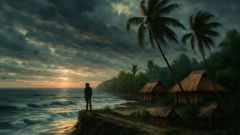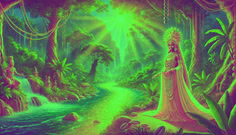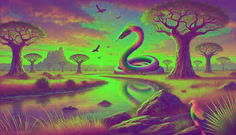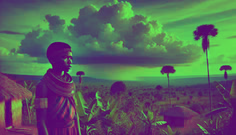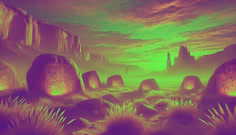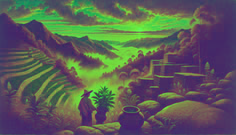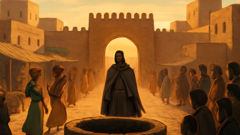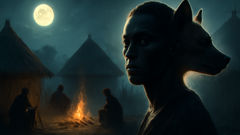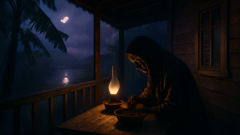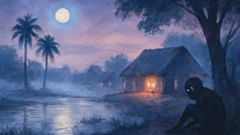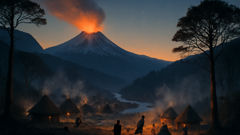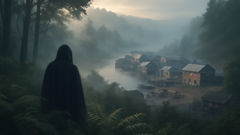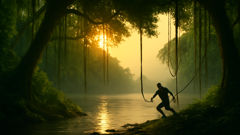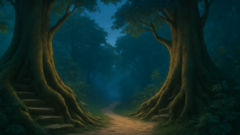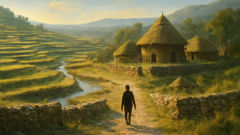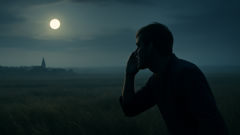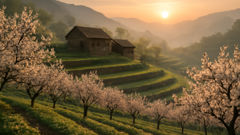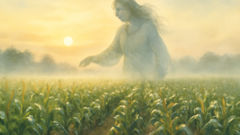Introduction
On the island the water remembers everything. Long before Spanish sails cut the blue, before concrete and radio towers, the people who came to call this land Borikén spoke of a force that lived between cloud and surf, a spirit whose voice was the going and coming of wind. They called him Juracán, named after the torn breath that tears leaves from trees and reshapes the beach. He is not a single face but a weather and a will: sometimes a low, keening pressure that lifts kites and nets into the air; sometimes a roar that breaks walls and scatters roofs; sometimes a lullaby that leaves a clean scent on the mangroves. This tale gathers the voices of elders, fishermen, and children who learned to read the sky, to sing to the palms, and to fold grief into story. It traces Juracán’s origin from the sputtering breath of creation, follows his moods as he tests the island’s villages and cliffs, and shows how the people—whose lives are braided with sea and soil—learned not only to survive but to listen. In those stories you will find how loss became memory, how fear grew into ritual, and how a god of chaotic weather became, paradoxically, a teacher of steadiness. A myth is a map for living; this one is carved from salt, wind, and resilient human hands.
Origins: Breath of the First Storm
In the oldest telling, before the people found names for rivers and rocks, Juracán was the breath of the sky-child. The creators—who shaped mountains and taught fire to tongues—were young then, and their play made weather. One of them, amused and a little fierce, blew a great gust that did not end. The wind found a rhythm and a voice; it took form in a swirling shape that delighted and frightened the first listeners. Juracán was made by accident and by will at once: a spirit of motion that would carry seeds and prayers, petals and ashes. He moved along the edge of things—the rim where ocean meets sand, the lip where forest meets clearing—and in that border he learned the taste of both salt and green leaf.
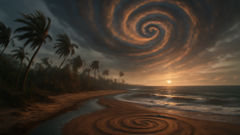
The Taíno spoke of him as a god of transitions because storms change one thing into another: land into sea, house into ruin, grief into song. In their cassava houses, by the glow of coals, great-grandparents would trace with fingers over the ground the path of a hurricane’s eye, and children would shuttle stones to mark the center and the circle. Those circles became calendars; the sweep of wind, a teacher. Juracán was capricious but consistent: he arrived at his own time, and when he did his voice made patterns that could be read. Hunters learned to watch the birds; fishermen read the way the flotsam swam. A sudden flock moving inland meant a change in pressure. The elders could tell when Juracán would be playful and when he would rage. That knowledge passed like flame from hand to hand, coastline to plateau.
Juracán’s temperament was not merely destructive. The earliest tales insist he had reasons shaped like storms themselves: an older god’s argument, the sea’s desire to draw a new inlet, a human wrong left unatoned. He visited villages to unsettle them and, in doing so, to test them. A community that learned to bury their dead with certain words or to plant forests in certain patterns might find Juracán’s fury tempered by ritual. In exchange, the island received renewal: sand carried from one beach to another, new channels dug by the sea that invited fish and mangrove roots. Those who could listen and respond with humility received not only mercy but gifts—shells laid out perfectly, fruit trees that would blossom heavier the year after a storm.
Yet the stories are careful: stewardship is not a guarantee. Generosity or neglect, gratitude or arrogance, could shape Juracán’s temper. There is a tale of a village that believed itself invincible, trimming trees too short and cutting back the forests that sheltered the cliffs. Juracán arrived in a shape like a giant mouth and took two roofs and a leaning statue before he left. The elders said afterward that the god had been testing the people’s humility; their laughter turned to work as they replanted and learned. Another story tells of a fisherwoman who refused to go below when the clouds turned; she stayed on her porch, singing for the wind. Juracán folded his arms and waited; when the worst passed she found her nets full of fish and her neighbor’s roof blown away. Some of Juracán’s gifts are hard to see, for they arrive mixed with loss.
These tales also describe the god’s many faces. To some he was a man with hair like a hurricane’s eye, eyes that swirled and spit salt; to others he was a great bird whose wings were the storm front. Some say he had no shape at all, only the feeling of pressure against the chest and the new-scent that arrives before rain. Children are told small, intimate versions: Juracán takes the cap of a laughing child and puts it where the tide meets the moon, and the cap becomes a shell. Those small stories teach a paradox: what is taken by wind is not always lost; sometimes it is transformed into an object of wonder. In the old language, his name could be a noun, a verb, and a weather report: Juracán is the storm, Juracán blows, Juracán will teach you how to survive.
This teaching, older than many houses and longer-lived than some lineages, shaped community life. People built on stilts, on raised mounds; they learned to store seeds in pots tucked high in the rafters; they planned work in seasons that followed sky and swell. Gardens were arranged so that if a gust tore up one row, the next row’s deeper roots held. Songs developed as memory-keepers—short tunes that reminded boys where to tie the boats and where to bury cassava when the rivers rose. Juracán, the god, gave the island a rhythm of caution and care. That rhythm would mark the islanders even when other languages arrived with new rulers. Juracán remained, whether named aloud beside a Christian prayer or kept in private song, because storms could not be governed by law or decree. The wind answers only what is in the air and what lives in the human heart.
Over time those lessons braided into festivals and quiet practices: offerings left at crossroads that faced the wind, shells placed where gusts could lift them, a knot in the rope of a hammock tied for protection. None of these was magic without meaning; they were social compacts, ways to show respect to a force that could otherwise strip dignity in a night. Juracán, then, was less a villain than a mandate. Stories insist he honors those who honor the land. If a field is left bare and the soil washed away, the people will say Juracán took back what had been harmed. If a lagoon is newly born and with it a carpet of mangrove seedlings, the villagers will leave a small dish of cornmeal in thanks. The god’s appetite is for balance. The oldest of the stories ends not in triumph but in a promise: the island will always know storms, but the island will also learn from them, build again, and make new places for fish and birds to live. That promise is the first kind of hope the wind taught them.
Tales of Fury and Renewal: Juracán and the People
Stories live in the mouths that survive storms and in the hands that mend. Across generations, Juracán’s visits stitched into the island’s daily life a mixed ledger of grief and gratitude. There are tales that begin at noon with the sun high and end at dawn with a changed horizon. One such story tells of a village named Punta Clara, perched on a promontory where the sea wraps like an arm. The people of Punta Clara were excellent fishers, and they had long net lines stretching like silver threads. One harvest season Juracán came in a mood that was angry and old; the sky folded like a book whose pages would not reopen. Winds took the nets, twisted them into the teeth of the rocks, and tore the thatch from houses. When the morning came, dogs howled and children sat on the stones counting what remained. But the elders did what elders always do: they collected the scattered goods and the broken lumber, and they sang songs that had the shape of rebuilding in them.
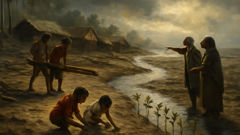
By the third day, a channel had opened where the cliff had been weakened by water. Fish followed the new current, and what had been a place where boats once had to pull hard now held a calmer pool. The community learned that in the night between loss and morning, a new reef had been heaped in the curve of the bay. They could have seen only the ruin; instead, they took the reef as a gift, and the song for the next fishing season carried a new chorus of thanks to Juracán. The tale lands on a careful moral: storm breaks and storm gives; the people’s work and their willingness to see generosity decide what they receive.
Elsewhere, on the island’s northern shelf, there is a tale of a woman named Anaca who lived at the edge of a broad lagoon. She was known for songs that could call fish from deep water. One summer the clouds thickened for weeks, and blue days were rare; the wind was a whisper that meant sharp change. The elders spoke of offerings that might soften the god’s temper. Anaca went alone to the high rocks at night and laid out plum-sized stones, polished and painted with charcoal, and sang into the wind. She sang of the birds and of the children who slept with the lull of waves. Juracán answered with a sudden breath so cold it burned like ice on the lips. He tore a tree from its roots and set it in the lagoon like a green mast. For days the water churned, but then the lagoon stilled and filled with small fish that had never been seen there before. Anaca, who had taken risks to speak to the wind, found her nets full and shared the bounty widely. In that sharing was an ethics: what Juracán offered belonged to all. The myth holds that reciprocity and courage were the virtues he admired.
Not all stories end with such tidy balance. There are sagas of suffering so deep that the island changed its name for some families. In these histories Juracán becomes something like a natural law—unforgiving when debt and harm have been done. A merchant’s greed, an unjust leader’s choices, a forest cut too far back—whatever hubris had shaped the land could call Juracán down in a way that would reset the ledger. A village that refused help to a neighbor lost both houses and harvest; the river carved new channels through their fields. Such narratives served as caution: the god’s power was a mirror of social balance. The taíno law of reciprocity—of give and take with the land and each other—was a bulwark against the kind of ruin that extracts more than the wind itself.
Juracán’s personalities also show tenderness in small, private stories, the sort told by grandmothers as children fall asleep. There’s the little myth of a boy who loved the sound of bottles clinking and who hung them in a tree as wind chimes. One year the wind took the boy’s favorite bottle and carried it far into the sea, only for a fisherman to return it months later, encrusted with salt and carved by a shellfish into a new, perfect shape. The boy learned to be patient, and the community learned to value small things differently. In this way Juracán was teacher, trickster, and sometimes benefactor. The weather he made could whisper secrets—like where a buried seed would sprout—and sometimes he simply made the world remind people to be humble.
With time and contact, other peoples arrived. New gods came with them, and names multiplied. Juracán’s stories changed but did not vanish; they threaded through other faiths and languages. A priest might say a prayer for shelter during a storm and an elder might tie a charm of woven sea-grass to a beam at the same time. That blending did not erase the old meanings but layered them. Juracán persisted as a cultural memory precisely because storms do not care for doctrine; they only respond to wind and water and land. Communities that survived the worst kept the old ways where they still made sense: watch the birds, bury seed high, sing at the first scent of rain. In this way the myth stood as a practical manual as much as a spiritual map.
In modern times, the island’s relationship with Juracán has adapted again. Concrete and asphalt change the way water travels; climate shifts make storms more frequent and fierce. Old rituals are sometimes not enough against industrial changes like deforestation and unplanned development. The myth now serves also as a kind of environmental fable—one that warns of the costs of forgetting the land’s rules. Activists and elders sometimes use the language of Juracán to explain the consequences of eroding mangroves or building on protective dunes. The god’s voice, in this telling, becomes the island’s conscience. When planners debate where to put a road or where to preserve a marsh, the elders remind them of Juracán’s lessons: the island is a system, delicate and interconnected. Protect the headwaters and the lagoons will thrive; keep the coastal forests and you keep the shorelines safer.
Yet even with changed meanings, the stories retain their human center. People still bake cassava cakes and leave them for the wind in a small clay dish when the sky turns the color of old metal. Children still count the rings left by waves on the sand, imagining Juracán’s fingers pressing into the earth. In classrooms and radios, writers and teachers retell the old myths so that the new generations remember why certain trees remain uncut at the water’s edge and why boats are stored with extra knots. Juracán’s myth functions on several levels: as history, as ecology, and as a repository of community knowledge. The god’s fury is real in both old and new ways, and the wisdom of the people who live with him is the story’s answer. That answer is not a single fix but a set of practices—repair, replant, remember—that make island life possible again after the wind has spoken.
Across these stories the motif that repeats is not only destruction but adaptation. Houses are rebuilt stronger or moved; new seedlings are planted where old trees fell; songs are taught to children as a survival instruction. Juracán’s voice becomes part of the island’s pedagogy: the children who know the stories learn to respect the margins where land and water meet and, perhaps more importantly, to respect each other. In sharing resources, in leaving room for fish and birds, in honoring what was taken in a storm, island communities practice a kind of social engineering that responds to the wind. The myth asks: what will you do when the things you hold dear are stripped away? The common answer across the tales is work, compassion, and the stubborn belief that island life can be rebuilt with hands that remember how to mend. Juracán’s visits, then, carve out not just physical changes but ethical expectations. The people learn that the god’s fury can be tempered—not by promises alone but by a long, patient practice of rebuilding in ways that serve both humans and the larger island. In that patience the island’s hope is found.
Conclusion
Juracán’s myth is not an old thing locked away; it is a living conversation between island and people. The god’s storms carved coves and peninsulas and taught generations how to live with uncertainty. Those who pay attention learn to make their homes in ways that respect wind and water, to read the sky like a map, and to pass down small rituals of repair that keep communities resilient. In modern language, the stories remind us that environmental systems are networks of consequence: what we cut, what we leave, what we plant matters. Juracán is a fierce teacher of ethics wrapped in weather, a reminder that survival requires listening and collaboration. The islanders’ rituals—songs at the water’s edge, offerings at crossroads, knots tied in hammock ropes—are methods of memory and care, and in their repetition they form a social architecture fit for storms. When a new storm comes, the god’s roar is still sharp, but so are the songs and hands that will answer. In that answering lives a stubborn, stubborn hope: that from salt and wind, from breaking and rebuilding, communities forge not only shelter but stories. Those stories carry the island forward, telling the next generation how to shape a life beside the sea with care, endurance, and the knowledge that even the fiercest wind can teach.

